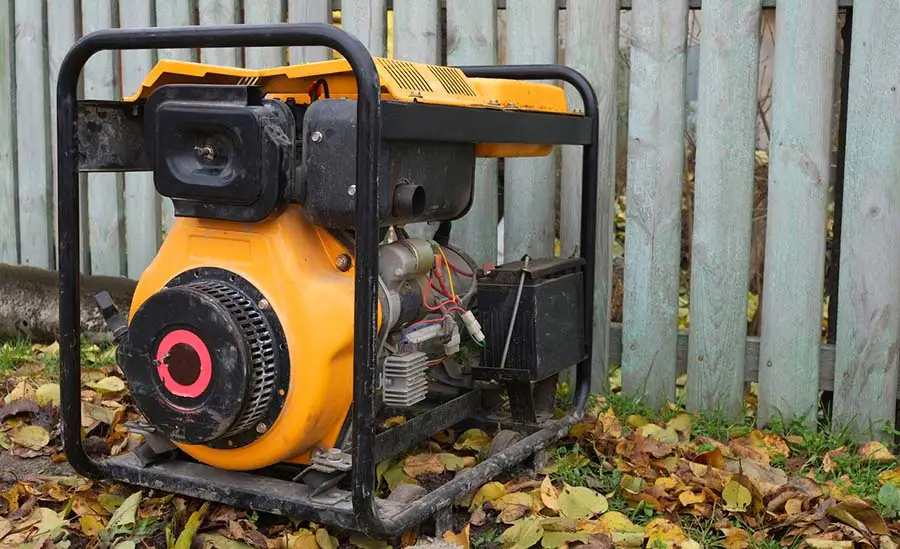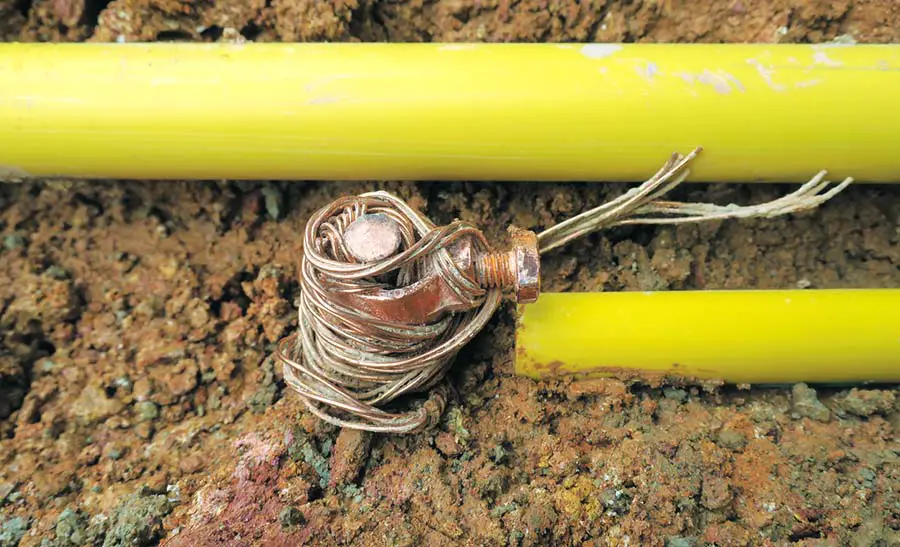
Grounding your generator can be extremely useful in prolonging the life of both the generator and the operator. A generator that you have not correctly grounded (or possibly not grounded at all!) can be hazardous to anyone nearby.
For generators that do not ground themselves through their frame, you must add a ground wire. Using a hammer, bury a grounding rod at least four feet into the dirt. Loosen the grounding bolt on your generator, and then attach a copper wire from the rod to your generator before tightening the bolt.
Pay attention to the following chapters to ensure that your generator is safe and ready to use safely. The OSHA guidelines listed below will ensure your safety and help you to avoid any electrical violations.
How To Ground a Generator
Portable generators are internal combustion engines and are extremely useful for when temporary electrical power is urgently required or for those occasions when no electrical power outlets are available in a remote location. Properly grounding your generator is crucial to ensure operator safety.
Grounding your portable generator can be a straightforward operation if you have the right tools at your disposal. We always recommend buying the best tools you can afford for the job.
Once you have completed this simple procedure, you may use your portable generator without the worry of possibly electrocuting yourself, and anyone else nearby, in the event of an electrical anomaly.
Tools That You’ll Need
- A Copper Grounding Rod – A copper grounding rod is made and designed to be driven firmly into any piece of ground wherein electrical current can be safely exhausted and dissipated. Acquire a grounding rod at least four feet in length although the recommendation for home installations is for an eight-foot rod.
- Copper Grounding Wire – You will use copper grounding wire to connect your generator to the copper grounding rod. Make sure that you have sufficient copper wire to reach to the grounding rod that you have driven into the earth.
- Wire Strippers and Pliers – You will need these to strip the copper grounding wire and connect it to the copper grounding rod and the generators grounding bolt.
- A Mallet – You will need a fairly heavy mallet to drive the copper grounding rod into the ground. You may also need a shovel and a spike for particularly firm ground. If the terrain is too hard to drive the rod straight into the ground, it may be hammered in at a 45-degree angle.
Ensure that you turn your generator to “off” before attempting to do any of the following.
1. Drive the Copper Grounding Rod Into the Ground
It is advisable to bury the entire length to ensure that the likelihood of electrocution decreases. A depth of four (minimum) to eight feet negates the possibility that electrical discharge from the grounding rod may electrocute people standing nearby.
2. Connect the Copper Grounding Wire to the Grounding Rod
Using the wire strippers, strip 6 to 12 inches off one end of the copper wire. Then, using your pliers, connect the wire to the top of the grounding rod by winding it tightly and securely around the rod.
3. Connect the Copper Grounding Wire to Your Generator
Strip about three inches off the other end of the copper grounding wire and, using your pliers, tightly wrap the exposed copper wire around the grounding bolt of your generator. Re-tighten the nut to ensure everything remains securely in place.
You can now use your generator secure in the knowledge that it is now safely grounded.
What Is Grounding a Generator?

Grounding an electrical circuit is simply a matter of utilizing a specific “earthing” system to ensure that any excess electrical discharge emanating from a power source transfers safely into the ground. Earthing or grounding a generator means that you have connected its neutral conductor to the ground.
When electricity is coursing through an electrical system, it is constantly looking to dissipate its energy by returning to the ground. In a standard electrical system (in this case, your portable generator), this electricity flows through “hot” wires through to a series of “neutral” electrical wires. If this system is compromised in any way, then that electricity will attempt to flow through the next path of least resistance.
If your generator is not sufficiently or adequately grounded, the current will follow the next path of least resistance, often ending up in places it should not ever be. This can spark a fire or electrocute the people standing around the generator.
Do You Need to Ground Your Generator?
As mentioned, all portable generators need to be grounded or “earthed” to be made safe. Again, a short circuit on an ungrounded generator can cause a fire or even death.
Fortunately, most generators manufactured these days are a single unit and incorporate the grounding mechanism into the metal frame around the motor. This frame will act as the path of least electrical resistance, ensuring that the current follows the frame into the earth. These are called non-separately derived systems.
Suppose you are the lucky possessor of a portable generator with a non-separately derived system. In that case, you may fire it up secure in the knowledge that it is safely grounded without any further input or hassle. Fortunately, most portable generators sold these days fall into this category.
The OSHA (Occupational Safety and Health Administration) Grounding Requirements for portable generators and for vehicle-mounted generators states the following:
“Under the following conditions, OSHA directs (29 CFR 1926.404(f)(3)(i)) that the frame of a portable generator need not be grounded (connected to earth) and that the frame may serve as the ground (in place of the earth):
The generator supplies only equipment mounted on the generator and/or cord and plug-connected equipment through receptacles mounted on the generator, § 1926.404(f)(3)(i)(A).
The non current-carrying metal parts of equipment (such as the fuel tank, the internal combustion engine, and the generator’s housing) are bonded to the generator frame, and the equipment grounding conductor terminals (of the power receptacles that are a part of [mounted on] the generator) are bonded to the generator frame, § 1926.404(f)(3)(i)(B).”
All those numbers, references, and regulations can be a little confusing so, to ascertain whether your generator needs to be grounded or not, you should take the time just simply to read carefully through your owner’s manual. The manufacturer will invariably provide a very clear and concise indication as to whether manual grounding by the operator is still a separate operation necessary to make your generator safe.
As mentioned, these days, the vast majority of portable generators sold into the retail market through big box stores such as Walmart, Home Depot, Target, and Lowe’s are of this type.
If you do not have access to the owner’s manual anymore (these things tend to become “lost” over time), then the best way of ascertaining whether you will need to perform a grounding function is to inspect the construction of your unit.
Check to see if the transfer switch (the electrical device that transfers your home’s internal electrical circuit from the main power grid to your portable generator) gives you the option to transfer current to a neutral ground conductor. If your generator indicates this, then the components of your generator will consist of a separately derived system. In this case, you will have to ensure that you ground your generator with a separate grounding electrode system.
Grounding requirements for generators connected via transfer switches are covered by Article 250 of the National Electrical Code (NEC).
Mike Holt has provided a most helpful resource in this regard:
The United States Department of Labor, Occupational Safety and Health Administration (OSHA) has this to say:
- “Maintain and operate portable generators in accordance with the manufacturer’s use and safety instructions.
- Never attach a portable generator directly to the electrical system of a structure (home, office, or trailer) unless the generator has a properly installed open-transition transfer switch.
- Always plug electrical appliances and tools directly into the generator, using the appliance manufacturers supplied cords. Use heavy-duty extension cords that contain a grounding conductor (3-wire flexible cord and 3-pronged cord connectors).
- Proper grounding and bonding are a means to prevent shocks and electrocutions.
- Use ground-fault circuit interrupters (GFCIs) as per the manufacturer’s instructions.
- Do not connect a generator to a structure unless the generator has a properly installed transfer switch.
- Visually inspect the equipment before use; remove defective equipment from service; mark or tag it as unsafe for use.”
They state further; if the frame of your generator acts as the grounding device:
“Under the following conditions, OSHA directs (29 CFR 1926.404(f)(3)(i)) that the frame of a portable generator need not be grounded (connected to earth) and that the frame may serve as the ground (in place of the earth):
– The generator supplies only equipment mounted on the generator and/or cord and plug-connected equipment through receptacles mounted on the generator, § 1926.404(f)(3)(i)(A), and
– The non current-carrying metal parts of equipment (such as the fuel tank, the internal combustion engine, and the generator’s housing) are bonded to the generator frame, and the equipment grounding conductor terminals (of the power receptacles that are a part of [mounted on] the generator) are bonded to the generator frame, § 1926.404(f)(3)(i)(B).
Thus, rather than connect to a grounding electrode system, such as a driven ground rod, the generator’s frame replaces the grounding electrode.”
However, if your generator does not have the requisite grounding system built-in by the manufacturer, the OSHA gives the following advice:
“If these conditions do not exist, then a grounding electrode, such as a ground rod, is required.
If the portable generator is providing electric power to a structure by connection via a transfer switch to a structure (home, office, shop, trailer, or similar) it must be connected to a grounding electrode system, such as a driven ground rod.
The transfer switch must be approved for use and installed in accordance with the manufacturer’s installation instructions by a qualified electrician.
Grounding requirements for generators connected via transfer switches are covered by Article 250 of the National Electrical Code (NEC).”
Safety Tips for Using and Grounding Your Generator

If used and operated without care, portable generators can prove to be extremely dangerous to the unwary in a working environment. It is essential to be aware of the following safe practices:
- Always read the instruction manual supplied with your generator carefully and completely. Follow the instructions and safeguards to the letter.
- Always inspect the generator before use. Ensure that all connections are secure and that the fuel filler cap is secure on its threads. If you find it to be unfit for service, remove it from the work area or your home and clearly mark it as unsafe for further use.
- Do not connect the generator to your electrical system if it does not have a correctly fitted transfer switch.
- Always use heavy-duty, flexible, 3-core, extension cords with a three-pronged electrical outlet plug to connect your generator to any appliance you wish to power.
- Critically, your generator must be carefully inspected on an annual basis to ascertain the integrity of the connections between the frame or the grounding system and that of the grounding or earthing systems of the equipment you are powering. This annual inspection should be performed by a competent electrician using the correct equipment, such as double-insulated tools. Upon inspection, the ohmic resistance should measure near zero and must not be intermittent, which would indicate a loose connection.
Conclusion
Grounding your portable generator is crucial to ensuring the correct usage of your generator. Properly grounding your unit will reduce the likelihood of breakdowns or component failure and will maintain the longevity of both you and your appliances.
Electricity is, by nature, extremely volatile. However, the electrical current has been efficiently contained and harnessed in a properly constructed and maintained circuit. It will provide a safe source of power for decades without undue attention or concern. The proviso here is that you should inspect your portable generator or have it inspected by a competent electrician annually.
On the other hand, I must stress that an ungrounded system is inherently a hazardous electrical system. As we have seen, a portable generator discharging current into anything other than its grounding system can cause significant appliance failure, sparks, fire, and even death.
We thoroughly recommend that your check your portable generator to ascertain whether it falls into the category of the separately derived system. If found to be so, do not use it any further until you have followed the simple steps outlined in this article and make it safe by grounding the components.

